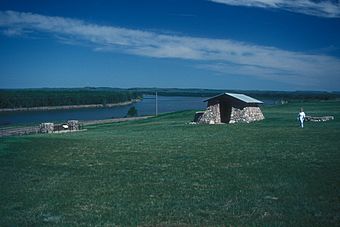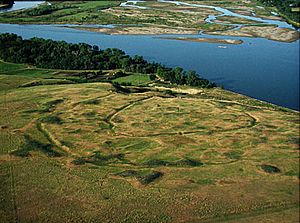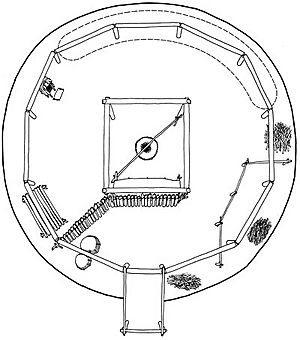Double Ditch facts for kids
Quick facts for kids |
|
|
Double Ditch State Historic Site
|
|
 |
|
| Lua error in Module:Location_map at line 420: attempt to index field 'wikibase' (a nil value). | |
| Nearest city | Bismarck, North Dakota |
|---|---|
| Area | 37.5 acres (15.2 ha) |
| NRHP reference No. | 79001769, 14000896 |
| Added to NRHP | January 29, 1979 |
Double Ditch is a really old village site located on the east bank of the Missouri River in North Dakota, near the city of Bismarck. It's also known as the Double Ditch State Historic Site. The name "Double Ditch" comes from the two big trenches you can still see today, which were once part of the village's defenses.
This site was once home to a Mandan Native American village. People lived here in special houses called earth lodges from about 1450 A.D. to 1785 A.D. The village was eventually left empty after a widespread illness affected many people. Today, you can still see the remains of these earth lodges, along with mounds of old trash (called midden mounds), and the defensive ditches. The State Historical Society of North Dakota helps protect and manage this important historical place.
Double Ditch is so important that it's listed on the National Register of Historic Places. It was recognized for its archaeological value in 1979 and later in 2014 for some park structures built there during the Great Depression.
What Was Life Like at Double Ditch?
The Mandan people who lived here built unique, dome-shaped homes called earth lodges. These houses were made from logs and covered with earth, making them strong and warm. If you visit the site, you'll notice raised areas around the village. These are called midden mounds, which are basically ancient trash piles! They can be anywhere from one to ten feet tall, and there are more than 30 of them around the village.
To keep the village safe, the Mandan people built strong defenses. They dug deep moats (ditches) and built tall walls of wooden posts, called palisades. They also used natural features like steep riverbanks and hilly ground to add extra protection.
How Did the Village Change Over Time?
In 2002, scientists used special technology called radio gradiometry to create detailed digital maps of Double Ditch. These new maps showed something amazing: there were actually two more ditches outside the two that everyone already knew about! This meant the village was much larger than previously thought.
When Double Ditch was first settled, just before the year 1500, it was a very big place. It covered about 19 acres and might have had as many as two thousand people living there!
Over time, the village started to shrink. In the mid-to-late 1500s, a new ditch (ditch 3) was built inside the very first one (ditch 4). This new area was also later abandoned, and another ditch (ditch 2) was built even further inside. By the year 1600, the village area had become 20 percent smaller. Scientists think this population loss might have been caused by things like long periods of dry weather (drought) or widespread illnesses.
By the mid-1700s, the innermost ditch was built. This enclosed an area of only four acres, meaning the population had dropped to fewer than four hundred people. Around this time, the entire surface layer of dirt in the village was carefully scraped off. This might have been done to clean the village thoroughly, perhaps after a very serious sickness.




